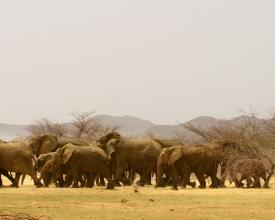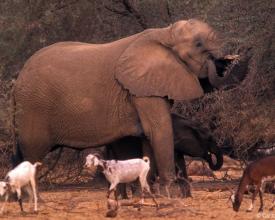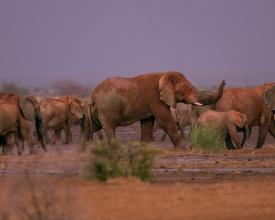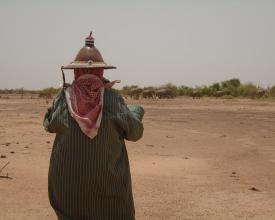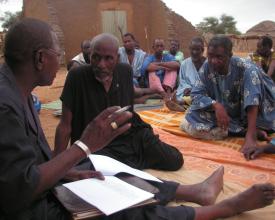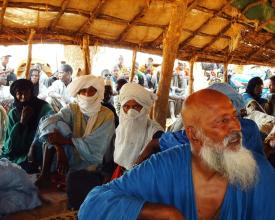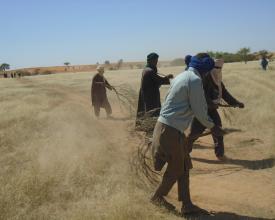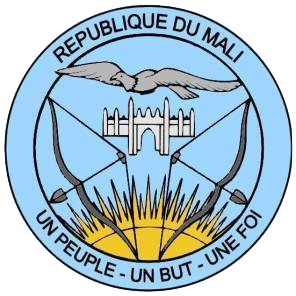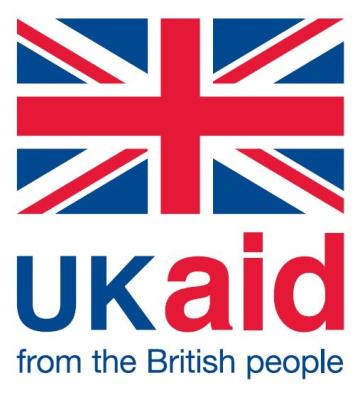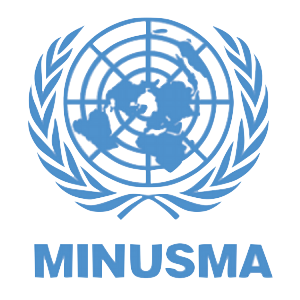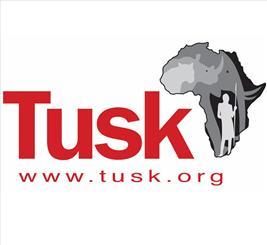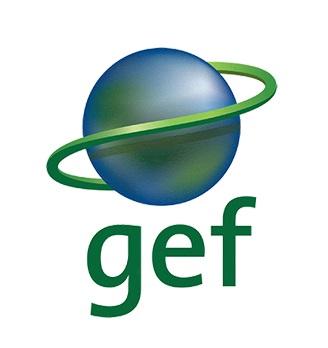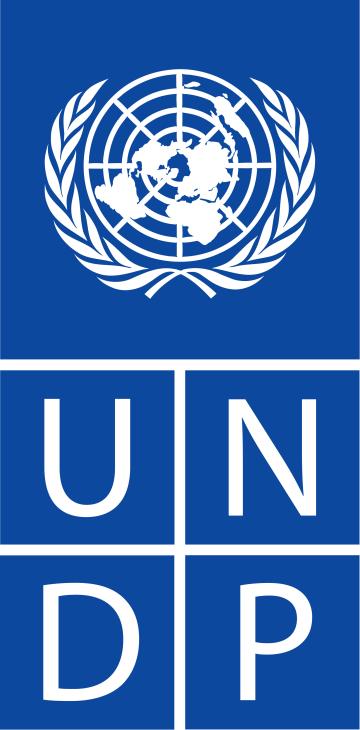
Recuperación de la naturaleza mediante la gestión comunitaria de los recursos naturales: una vía hacia la resiliencia ecológica y social
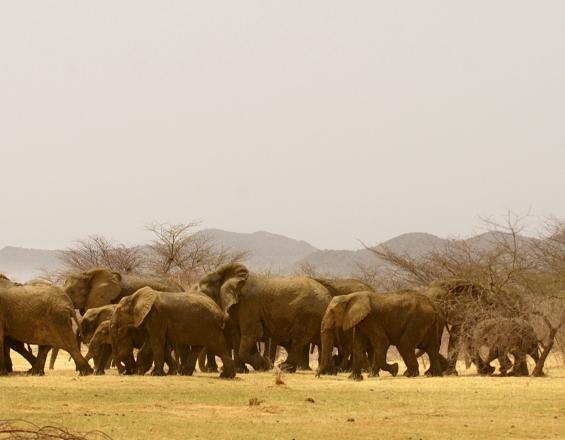
El Proyecto Elefante de Malí aplica un enfoque integrado a nivel de paisaje al complejo problema de la coexistencia de la fauna y la flora a lo largo de 42.000 km2. Basándose en los múltiples valores que los agentes locales asocian a la presencia de elefantes, el proyecto trabaja simultáneamente a múltiples niveles, utilizando un enfoque participativo con las partes interesadas para crear conjuntamente soluciones que protejan una de las últimas poblaciones de elefantes que quedan en África Occidental. La pérdida de hábitat provocada por el hombre, la degradación medioambiental, los conflictos y la caza furtiva amenazan tanto a los elefantes como a los medios de vida locales. Para combatirlos, el proyecto apoya a las comunidades locales del área de distribución de elefantes en el establecimiento de sistemas de gestión de recursos naturales centrados en la comunidad que protejan el hábitat natural e inviertan la degradación medioambiental. Un medio ambiente más sano favorece los medios de subsistencia locales, proporciona ocupaciones a los jóvenes en situación de riesgo y oportunidades de generación de ingresos, especialmente para las mujeres. Estos sistemas también fomentan la cohesión social y refuerzan el apoyo local a la conservación de los elefantes.
Contexto
Défis à relever
- Anarquía, conflictos e insurgencia por parte de grupos extremistas
- Impotencia de las comunidades para impedir la pérdida de hábitats y la degradación de los ecosistemas, lo que empobrece los medios de subsistencia.
- Sobreexplotación por rebaños crecientes y otros intereses comerciales procedentes de centros urbanos distantes.
- Las tensiones sociales entre clanes y etnias por el acceso a los recursos naturales hacen que no existan sistemas de gestión respetados colectivamente.
- Caza furtiva de elefantes, ya que la zona del proyecto se encuentra a horcajadas de las principales rutas internacionales de tráfico.
- La caza no regulada ha provocado la desaparición de muchas especies silvestres.
- Aumento de los conflictos entre humanos y elefantes, desplazados de sus refugios por grupos armados que ocupan densos matorrales alrededor de los abrevaderos, junto con los efectos de la minería artesanal de oro.
- Desempleo juvenil y vulnerabilidad al reclutamiento por parte de grupos armados.
- Falta de capacitación económica y social de jóvenes y mujeres.
- Falta de capacidad del Gobierno para proteger a los elefantes y gestionar las zonas protegidas.
Ubicación
Procesar
Resumen del proceso
Todos los elementos básicos están íntimamente relacionados y derivan del primero, la perspectiva de "complejidad" del proyecto, que considera que el problema surge de las relaciones de su contexto más amplio entre las personas y entre éstas y la naturaleza. Guiado por una visión de coexistencia pacífica entre humanos y elefantes, encuentra formas de reforzar los aspectos positivos y resolver las relaciones negativas mediante una acción cuidadosa. Requiere una mentalidad abierta para respetar las perspectivas de todas las partes interesadas; colmar lagunas de conocimiento; identificar y poner en red "activos" y puntos clave de intervención para la acción. Implica facilitar la creación conjunta de una perspectiva común entre las partes interesadas, seguida de soluciones transparentes y justas a nivel de base, "habilitadas" además por una nueva legislación (por ejemplo, la nueva Reserva de Gourma). El diálogo y el aprendizaje continuos entre las partes interesadas son fundamentales. El efecto dominó va más allá de la mera conservación de los elefantes, convirtiéndose en una fuerza motriz para mejorar la resiliencia ecológica y social. Adoptar una visión amplia del problema y centrarse en las relaciones dentro del ecosistema social y ecológico ofrece más oportunidades para soluciones creativas, como por ejemplo, ofrecer una ocupación a los jóvenes en situación de riesgo en la protección de los recursos naturales y la restauración de la tierra.
Bloques de construcción
La aplicación de un enfoque de sistemas complejos para abordar un reto de conservación permite mejorar múltiples ODS
Ninguna especie existe en el vacío. Un sinfín de fuerzas interactivas intervienen en su destino a niveles que van mucho más allá de su entorno ecológico directo. Reconocerlo significa dejar de centrarse únicamente en la especie para abarcar todo el sistema (ecológico, social, político, económico) en el que vive. También implica aceptar la incertidumbre que surge de estas interacciones "que afectan simultáneamente al sistema más amplio y son moldeadas por él" (Canney, 2021). Esto significa que las soluciones preconcebidas tienen muy pocas posibilidades, o ninguna, de tener verdadero éxito.
No saber qué hacer obligó al proyecto a preguntar, observar y escuchar, dejando que el contexto moldeara la respuesta. A lo largo de los años, ha significado comprender el contexto socioecológico para identificar puntos clave de intervención en los que pequeñas aportaciones pueden tener repercusiones relativamente grandes, "planificar un mayor grado de flexibilidad para responder a lo inesperado, aprovechar las oportunidades y adaptarse a las circunstancias cambiantes" (ídem), y trabajar a distintos niveles y con diversas partes interesadas para alcanzar los objetivos. Aunque en un principio se centró en los elefantes, este planteamiento ha reportado múltiples beneficios y ha contribuido a mejorar muchos problemas a la vez, desde la degradación de los ecosistemas hasta la puesta en peligro de los medios de subsistencia, el desempleo juvenil, la gobernanza local y los conflictos sociales.
Factores facilitadores
Dedicar tiempo a comprender e interiorizar la teoría de los sistemas complejos y tratar de identificar cómo las soluciones simples y "controlables" tienen consecuencias imprevistas cuando se aplican a situaciones complejas.
Dedicar tiempo a adquirir conocimientos ecológicos y sociales.
Centrarse en las redes, la conexión y la dinámica en lugar de en entidades individuales y en la simple causa y efecto.
Un periodo preliminar de estudio del problema en su contexto más amplio.
Una organización anfitriona (la Fundación WILD) dispuesta a apoyar un enfoque poco convencional (y, por tanto, arriesgado) de la conservación.
Lección aprendida
Esté preparado para no tener la respuesta y reconozca que no sabe qué hacer.
Cuestionarse continuamente por qué aparece un fenómeno y buscar las causas últimas.
Busca la comprensión en un espectro de disciplinas, perspectivas e individuos y reconoce que todas son interpretaciones parciales.
Respeta a todos, incluso a los que actúan en tu contra.
Sé flexible, adáptate a la situación local: si un planteamiento no funciona, busca el porqué, sigue intentándolo hasta que encuentres la solución. En entornos dinámicos, las soluciones necesitarán una revisión continua.
Si quieres que alguien haga algo, crea el contexto que fomente esa acción, así no tendrás que estar gastando recursos en hacer cumplir la ley.
Sea muy transparente y honesto en sus motivaciones y espere lo mismo de las personas con las que trabaja para generar confianza. Actúe con motivaciones genuinas y guíese por el contexto local en lugar de por "soluciones de plano".
Equilibrio de disciplinas y competencias complementarias en el equipo. En este caso, el Director tenía formación en ciencias naturales y cierta experiencia en ciencias sociales, mientras que el Jefe de Campo era un antropólogo social con conocimientos de ciencias naturales.
Utilizar un enfoque verdaderamente co-creativo y adaptado a las circunstancias locales para la participación y gobernanza de la comunidad y de las partes interesadas.
El enfoque del proyecto respecto a la participación de la comunidad consiste siempre en escuchar primero, comprender los problemas y preocupaciones locales y debatir la cuestión de los elefantes en este contexto. Reconocer todos los puntos de vista y desarrollar una perspectiva común del problema es un primer paso clave. Identificar los parámetros del problema y la visión común es el siguiente paso. Para entonces, pedir a las comunidades que conciban una solución, con el MEP como parte interesada, genera su confianza e imparte propiedad, fomentando así la sostenibilidad.
Implica muchas incógnitas, requiere flexibilidad y disposición a aprender, pero significa que las iniciativas tienen muchas más probabilidades de éxito porque se basan en los conocimientos y la experiencia locales existentes, y son validadas y adoptadas automáticamente por los participantes desde el principio, elementos esenciales para crear soluciones adaptadas localmente y, por tanto, sólidas/resilientes.
El proceso implica la participación activa de los alcaldes de los municipios y de los servicios técnicos del gobierno, cuyo papel es apoyar a las comunidades en la puesta en marcha de iniciativas locales y su integración en los planes de desarrollo de los municipios. Todos tienen que demostrar su compromiso para que las actividades del proyecto sigan adelante. Esto refuerza la gobernanza local al capacitar a todas las partes interesadas para asumir juntas la responsabilidad de la gestión de sus recursos naturales.
Factores facilitadores
La legislación de descentralización de Malí pone la gestión de los recursos naturales en manos de las comunidades locales.
Abordar el problema con una mentalidad abierta, sin una solución preconcebida, dejando que el contexto local diera forma a la solución y que ésta surgiera de un diálogo abierto con las comunidades locales fue clave para establecer la confianza y la colaboración.
Reunir un equipo local originario de la zona, con un auténtico conocimiento de las costumbres locales, la cultura y sus sutiles variaciones, y sólidas dotes de facilitación es uno de los activos más fuertes del proyecto.
Lección aprendida
El uso del suelo (hábitat y biodiversidad) es el problema clave en estos entornos.
Este planteamiento garantiza la aceptación y la confianza de la comunidad, esenciales para el éxito a largo plazo.
Era desalentador implicar a las comunidades locales por si se decidían en contra de la conservación de los elefantes, pero era la única forma de idear una solución sostenible y resultó que la gran mayoría valoraba a los elefantes.
Es importante que el equipo local sea de la zona, apasionado por la causa. Puede que no sean los más cualificados, pero su capacidad como facilitadores es la cualidad predominante para el éxito, junto con una motivación genuina y la fiabilidad.
Significa desarrollar su capacidad en otras áreas, lo que puede llevar más tiempo, pero es mejor que coger a personas cualificadas de otros lugares y fundamentar aún más su contribución a nivel local.
La gente puede decir las cosas que percibe como más ventajosas para ellos, razón de más para contar con facilitadores locales. También ha significado que el proyecto ha podido continuar a pesar de la extrema anarquía.
Las comunidades locales estaban entusiasmadas con la visión a largo plazo de restaurar el ecosistema y la vida salvaje que se habían perdido.
La gestión comunitaria de los recursos naturales "centrada en los elefantes" (CBNRM) como consolidación de la paz.
Cuando comes alrededor de una hoguera tras un día de trabajo en común construyendo cortafuegos, te das cuenta de que todos tenemos los mismos problemas".
En un contexto de recursos limitados, dar cabida a diferentes prácticas de subsistencia (pastoreo, agricultura) que a menudo entran en conflicto requiere un diálogo que empiece desde la base. Por eso el proyecto actúa como facilitador para ayudar a reunir a los diversos clanes y etnias de la zona de distribución de elefantes con el fin de lograr la unidad hacia un objetivo común: en este caso, la conservación de sus recursos naturales y la regeneración de su ecosistema.
Al unirse para abordar un reto medioambiental, las comunidades se benefician a múltiples niveles, lo que las incentiva a seguir colaborando. El resultado es una solución más resistente que la suma de sus partes. Los beneficios incluyen hábitats más sanos, recursos naturales más abundantes, mayor seguridad alimentaria y resistencia ante acontecimientos adversos, ingresos adicionales, empoderamiento social, incluido el de las mujeres y los jóvenes, mejor cohesión social entre las comunidades y dentro de ellas, mayor seguridad física al ofrecer a los jóvenes una ocupación respetada localmente como "ecoguardas", lo que reduce la probabilidad de que emigren o se unan a grupos armados, y orgullo por su capacidad de contribuir a su hogar y su comunidad, y ejercer cierta influencia sobre sus vidas.
Factores facilitadores
Las actitudes positivas de la población local hacia los elefantes y su comprensión de que todos compartían los mismos problemas constituyeron el factor unificador en torno al cual empezar.
Jóvenes desempleados en busca de un papel más hábitats degradados y tierras que requieren protección y restauración.
Lección aprendida
Los conflictos entre los seres humanos y la fauna silvestre tienen como núcleo los conflictos entre los seres humanos. Por eso es importante entender quién se beneficia y quién pierde y cuáles son las relaciones de poder, por ejemplo.
Los jóvenes desempleados locales buscan un papel que contribuya a sus familias y a la comunidad y que sea respetado localmente. Esto es más importante que el dinero. Son, por tanto, un gran recurso. Involucrarlos, darles un sentido y un propósito, puede ser una herramienta poderosa (por ejemplo, actuar contra el reclutamiento por parte de grupos armados). Cualquier recompensa inicial puede ser de "reconocimiento", no un salario, lo que proporciona los medios para un mayor desarrollo bajo sus propios esfuerzos.
Es importante discutir primero el papel de los ecoguardas e identificar las cualidades requeridas antes de pedir a la comunidad que designe a los individuos.
Crear una red de asociaciones y alinear los intereses en torno a una visión común - No vaya por libre.
Adoptar un enfoque de "sistemas complejos" significaba movilizar a todas las partes interesadas del área de distribución de elefantes en torno a una visión común: la conservación de los elefantes de Gourma, un patrimonio nacional e internacional. Para ello, se organizaron talleres con todos ellos (administración pública y servicios técnicos, industria turística, escuelas, proyectos, programas y ONG que operan en la zona) para conocer sus puntos de vista y diseñar materiales y actividades de divulgación impactantes (incluido un programa escolar). También supuso implicar y coordinar el apoyo de otras instituciones del país (por ejemplo, embajadas extranjeras, MINUSMA, PNUD).
A nivel nacional, esto ha incluido trabajar con el gobierno para redactar un plan de gestión de elefantes; crear una unidad mixta (forestal-militar) contra la caza furtiva y contratar a instructores expertos en la lucha contra la caza furtiva de Chengeta W.; y crear una nueva área protegida que cubra toda la ruta migratoria de los elefantes, utilizando un modelo de reserva de la biosfera. Las zonas de usos múltiples se rigen por convenios locales de gestión comunitaria de los recursos naturales, y los guardas forestales se encargan de hacer cumplir la ley si es necesario, reforzando así los sistemas comunitarios. Esto alinea los intereses del gobierno y de la comunidad para reforzarse mutuamente y proporcionar un enfoque rentable a la gestión de la reserva. Este enfoque descendente complementa el enfoque ascendente de la participación comunitaria.
Factores facilitadores
Utilizar a los elefantes como factor unificador para todas las partes interesadas
Cultivar socios locales capaces de reunir la información local necesaria e identificar a los agentes pertinentes.
Identificar a las personas que ocupan puestos clave en los ministerios pertinentes que apoyan el proyecto y reunirlas para que se apoyen mutuamente.
Una organización asociada que pagara los salarios básicos permitió al proyecto recaudar fondos y "despegar".
Lección aprendida
Aunque trabajar con múltiples socios lleva tiempo y puede ser difícil, los resultados son mucho más sostenibles y resistentes porque todas las partes participan en el proceso y, con suerte, obtienen algún beneficio.
El margen para hacer concesiones fue mayor de lo previsto inicialmente.
Mantener el compromiso de las partes interesadas gubernamentales, sobre todo cuando el gobierno es muy disfuncional, puede requerir un esfuerzo continuo, pero es esencial para crear capacidad y apropiación nacionales.
Las personas que ocupan puestos clave pueden obstaculizar o facilitar enormemente las actividades. Se puede utilizar un enfoque de sistemas complejos para tratar de comprender el "panorama del poder" y encontrar formas de limitar su impacto, por ejemplo encontrando formas indirectas de que se hagan públicos los comportamientos obstruccionistas o las malas prácticas.
Gobernanza de los recursos comunitarios en apoyo de la planificación de áreas protegidas y paisajes (sinergia de arriba abajo/abajo arriba).
El MEP utilizó la legislación de descentralización de Malí para crear, con la población local, un modelo de CBNRM "centrado en los elefantes". Esta legislación desempeñó una función facilitadora vital que dio lugar a un modelo de gobernanza de los recursos a nivel de aldea y comuna, que quedó consagrado en las convenciones locales y comunales, así como en los planes de desarrollo socioeconómico de las comunas. A continuación, el diputado trabajó con el gobierno para reforzar estos sistemas mediante la redacción de una nueva legislación que creaba una nueva área protegida que abarcaba toda la ruta migratoria de los elefantes, utilizando un modelo de biosfera que apoyaba las convenciones comunitarias. El objetivo era dar un mandato a los silvicultores del gobierno para que pudieran apoyar a las comunidades locales en la aplicación de sus convenios en caso necesario, reforzando así los sistemas comunitarios. De este modo se alinean los intereses gubernamentales y comunitarios para reforzarse mutuamente y ofrecer un enfoque rentable de la gestión de las reservas. Este enfoque descendente complementa el enfoque ascendente del compromiso comunitario.
Factores facilitadores
El modelo de CBNRM "centrado en el elefante" que se había ideado.
Lección aprendida
La importancia de una legislación habilitante para catalizar la capacitación de las bases.
La necesidad de un organismo neutral de "facilitación" que reúna a las distintas partes de la comunidad.
La velocidad del proceso de creación de una nueva legislación es larga y depende del grado de compromiso y defensa de la iniciativa por parte de los socios gubernamentales; sin embargo, las ONG pueden proporcionar apoyo técnico y recordatorios para generar movimiento hacia delante.
Impactos
El enfoque integrado y paisajístico del proyecto ha supuesto que, aunque el objetivo inicial era la conservación de los elefantes, el método resultante ha producido múltiples resultados que contribuyen a varios ODS.
Las comunidades se sienten capacitadas para mejorar su bienestar asumiendo la responsabilidad de la gestión de los recursos naturales que son la base de los medios de subsistencia locales. Esto les confiere un sentimiento de propiedad.
"Si los elefantes desaparecen significa que el medio ambiente ya no es bueno para nosotros".
El resultado ha sido la restauración y regeneración del medio ambiente y la creación de hábitats sanos y viables para los elefantes y otros animales salvajes.
Otros beneficios son la mejora de los medios de subsistencia, la gobernanza local (a nivel de comunas y aldeas), la cohesión social, las ocupaciones para los jóvenes, las oportunidades para las mujeres y una forma de resolver los conflictos entre humanos y elefantes.
Todo ello crea resiliencia medioambiental y social, reforzando el apoyo a la conservación de los elefantes entre las comunidades locales y las administraciones de las comunas, y estos convenios locales se convierten en parte integrante de los planes de desarrollo social y económico de las 16 comunas pertinentes.
La colaboración con el Gobierno ha dado como resultado un plan de gestión de los elefantes; la creación de una nueva zona protegida que abarca los 42.000 km2 del área de distribución de los elefantes, incluidos mecanismos de aplicación de la ley; y la creación de la primera unidad de lucha contra la caza furtiva de Malí que, con la confianza y el apoyo de la comunidad, impidió el exterminio de los elefantes.
Beneficiarios
Los principales beneficiarios son las comunidades locales de Gourma y el gobierno de Malí. Como patrimonio nacional e internacional, la conservación de los emblemáticos elefantes de Gourma también beneficia a la población de Malí, África Occidental y el mundo entero.
Objetivos de Desarrollo Sostenible
Historia
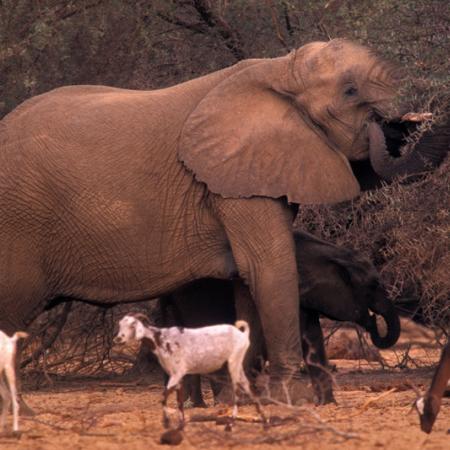
Cuando se inició el MEP en 2003, la creciente presión humana había provocado la pérdida y degradación del hábitat, la reducción de la resiliencia ambiental y social y el empobrecimiento de los medios de subsistencia, lo que exacerbó los conflictos sociales y entre humanos y elefantes.
Las encuestas de actitud revelaron que la población local no quería que los elefantes desaparecieran: entendían que eran un signo de un ecosistema sano y que las actividades humanas debían respetar los límites medioambientales. Otros estudios y consultas revelaron más información sobre los factores subyacentes, los problemas de las comunidades, sus sistemas de valores y su relación con los elefantes. El uso anárquico de los recursos naturales estaba en el centro y los grupos individuales eran incapaces de actuar contra él. Esto significaba que la legislación de descentralización de Malí era una herramienta adecuada para ayudar a crear consenso entre los diversos grupos locales sobre sistemas de gestión de recursos que permitieran la restauración y el uso sostenible de los recursos naturales en beneficio de las personas y los elefantes.
Estos sistemas de CBNRM "centrados en los elefantes" implicaban la creación de estructuras comunitarias: comités de ancianos apoyados por jóvenes ecoguardas comunitarios desarmados, seleccionados por cada comunidad para patrullar y hacer cumplir los acuerdos comunitarios, así como para llevar a cabo actividades de protección y restauración de los recursos y concienciar a la población local.
Las normas comunitarias protegían sus recursos (agua, pastos, bosques, vida salvaje) de la sobreexplotación y declaraban bosques protegidos y reservas de pastos, protegidos con cortafuegos construidos por los ecoguardas. Ese año, a medida que avanzaba la estación seca y estallaban los incendios, sus pastos sobrevivieron. Tenían pastos de sobra para su ganado al final de la estación seca y podían vender heno y acceso a los pastos a buen precio a otros. Su ganado valía un 50% más en el mercado, tenía más crías y menos enfermedades. Las mujeres pudieron crear empresas locales basadas en la disponibilidad de recursos naturales, como la venta de heno, forraje y productos forestales como la goma arábiga. Estas actividades también fomentaron la armonía dentro de la comunidad y ayudaron a curar las tensiones entre etnias.
Las normas comunitarias incluían el reparto de beneficios, reforzando así el apoyo local a la conservación de los elefantes. Cuando apareció la caza furtiva de elefantes con la llegada de los conflictos y la anarquía, los ecoguardas comunitarios vigilaron a los elefantes, la caza furtiva y el HEC. Cuando la caza furtiva se intensificó en 2015, solicitaron apoyo gubernamental contra la caza furtiva. El MEP colaboró con el Gobierno para crear una unidad de lucha contra la caza furtiva en Gourma y una nueva zona protegida en el área de distribución de los elefantes siguiendo el modelo de una reserva de la biosfera.
